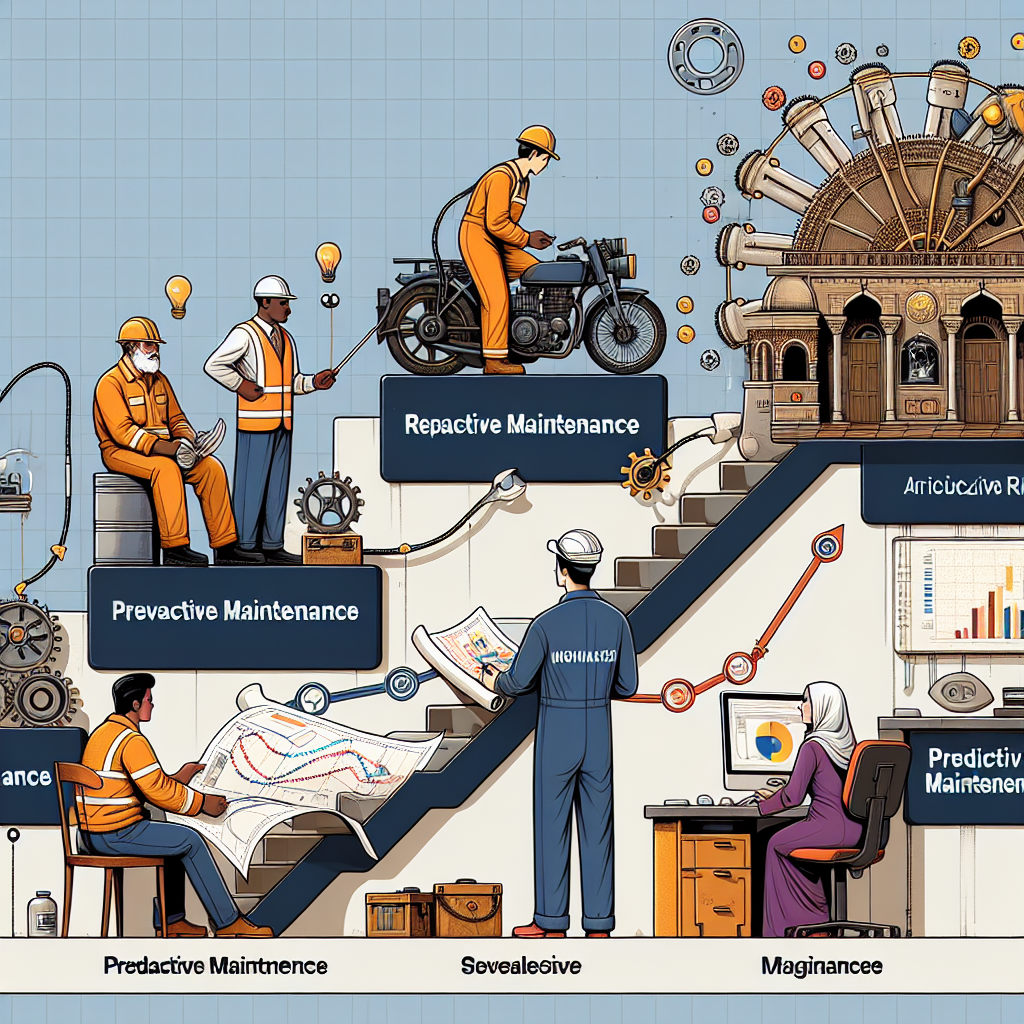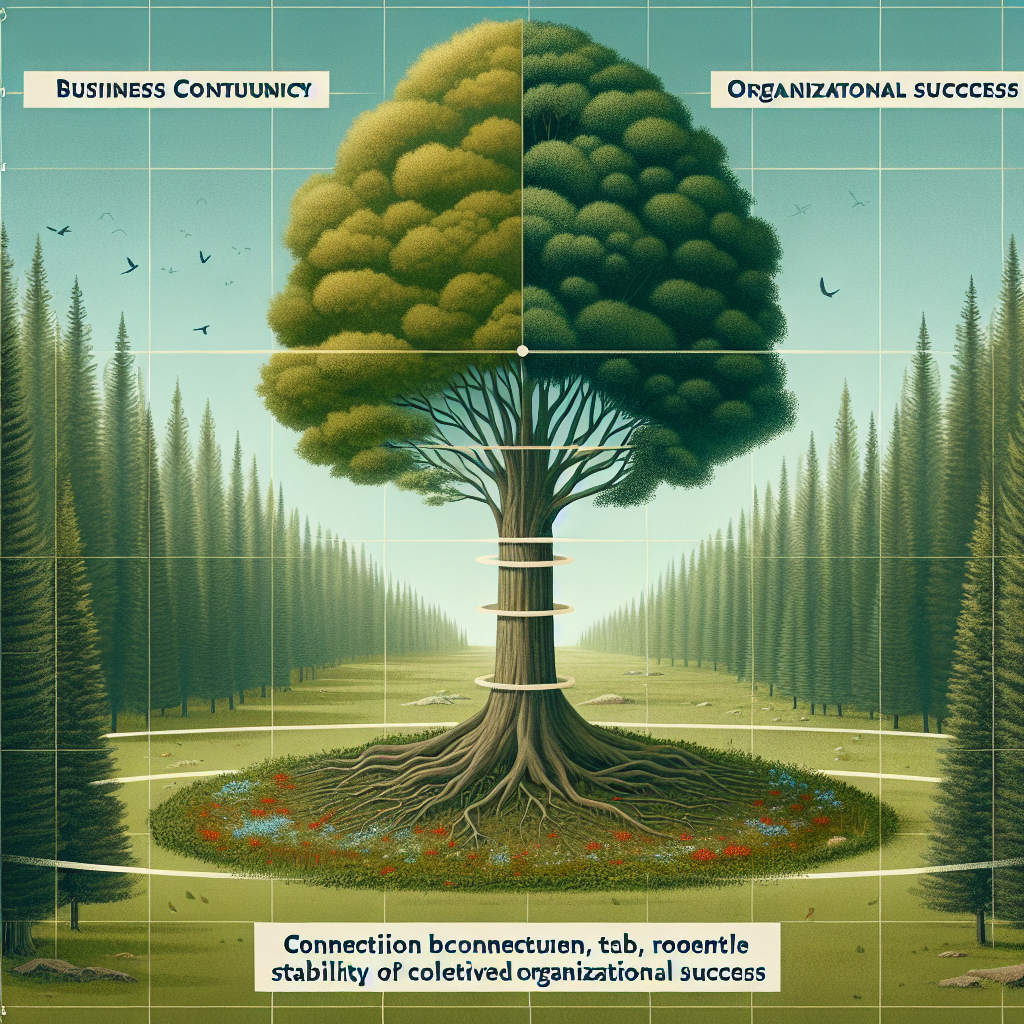Your cart is currently empty!
Tag: Success

The Evolution of Maintenance: Embracing Proactive Strategies for Success
Maintenance has always been a crucial aspect of ensuring the longevity and efficiency of equipment, machinery, and infrastructure. Traditionally, maintenance strategies have been reactive in nature, meaning that maintenance activities are performed in response to equipment failures or breakdowns. However, as industries and technologies continue to evolve, so too must maintenance practices. In today’s fast-paced and competitive business environment, proactive maintenance strategies have become essential for success.The evolution of maintenance from reactive to proactive approaches has been driven by several factors. One of the key drivers is the increasing complexity and sophistication of modern equipment and machinery. With the advent of advanced technologies such as IoT, AI, and predictive analytics, equipment is now capable of providing real-time data on its performance and condition. This data can be used to predict potential failures before they occur, allowing maintenance teams to proactively address issues and prevent costly downtime.
Another factor driving the shift towards proactive maintenance is the growing emphasis on sustainability and environmental responsibility. By adopting proactive maintenance strategies, organizations can minimize their environmental impact by reducing energy consumption, waste, and emissions. Proactive maintenance also helps to extend the lifespan of equipment, reducing the need for frequent replacements and the associated environmental costs.
In addition to these factors, the increasing pressure to optimize operational efficiency and reduce costs has also played a role in the adoption of proactive maintenance strategies. By preventing breakdowns and improving equipment reliability, proactive maintenance can help organizations maximize productivity, minimize downtime, and reduce maintenance costs in the long run.
So, what does proactive maintenance look like in practice? Proactive maintenance involves a shift from reactive, time-based maintenance schedules to condition-based maintenance. This means monitoring equipment in real-time to detect anomalies and potential issues, and taking corrective action before they escalate into major problems. Predictive maintenance techniques, such as vibration analysis, thermal imaging, and oil analysis, can be used to identify early warning signs of equipment failures and schedule maintenance activities accordingly.
Furthermore, proactive maintenance also involves a focus on continuous improvement and optimization. By analyzing maintenance data and performance metrics, organizations can identify trends and patterns that can help them fine-tune their maintenance strategies and improve overall equipment reliability.
In conclusion, the evolution of maintenance towards proactive strategies is essential for organizations looking to stay ahead in today’s competitive business landscape. By embracing proactive maintenance approaches, organizations can improve equipment reliability, reduce downtime, minimize costs, and enhance operational efficiency. As technology continues to advance and industries become increasingly complex, proactive maintenance will be a key differentiator for success in the future.

Measuring Success: Key Metrics for Evaluating Technical Support Performance
Technical support is a critical component of any business that relies on technology to operate efficiently. Whether you’re providing support for internal employees or external customers, it’s important to measure the success of your technical support team to ensure they are meeting the needs and expectations of those they serve. By tracking key metrics, you can evaluate the performance of your technical support team and identify areas for improvement. Here are some key metrics to consider when measuring the success of your technical support team.First Call Resolution Rate:
One of the most important metrics for evaluating technical support performance is the first call resolution rate. This metric measures the percentage of support requests that are resolved on the first call without the need for additional follow-up. A high first call resolution rate indicates that your technical support team is knowledgeable, efficient, and able to resolve issues quickly. On the other hand, a low first call resolution rate may indicate that there are gaps in training or resources that need to be addressed.
Average Response Time:
Another important metric to consider is the average response time for support requests. This metric measures the amount of time it takes for a support representative to respond to a request for assistance. A low average response time indicates that your technical support team is responsive and able to provide timely assistance to those in need. However, a high average response time may indicate that there are delays in addressing support requests, which can lead to frustration and dissatisfaction among users.
Customer Satisfaction:
Customer satisfaction is a key indicator of the overall success of your technical support team. By surveying customers after receiving support, you can gather feedback on their experience and determine how well your team is meeting their needs. A high customer satisfaction score indicates that your technical support team is providing excellent service and meeting the expectations of your users. On the other hand, a low customer satisfaction score may indicate that there are areas for improvement in the quality of support being provided.
Ticket Volume:
Tracking the volume of support tickets can also provide valuable insights into the performance of your technical support team. A high volume of support tickets may indicate that there are underlying issues with your technology infrastructure that need to be addressed. It can also indicate that there are gaps in training or resources that are causing users to experience more issues than usual. By monitoring ticket volume, you can identify trends and patterns that can help you address underlying issues and improve the overall performance of your technical support team.
By tracking these key metrics, you can evaluate the performance of your technical support team and make data-driven decisions to improve the quality of support being provided. By monitoring first call resolution rate, average response time, customer satisfaction, and ticket volume, you can identify areas for improvement and ensure that your technical support team is meeting the needs and expectations of those they serve.

Leveraging Service Level Agreements to Drive Business Growth and Success
Service level agreements (SLAs) are a crucial aspect of any business relationship, as they define the expectations and responsibilities of both parties. While SLAs are often seen as a way to ensure that service providers meet their obligations, they can also be leveraged by businesses to drive growth and success.One of the key benefits of a well-crafted SLA is that it can help align the goals of the service provider with those of the business. By clearly outlining the desired service levels, response times, and performance metrics, an SLA can ensure that the service provider is working towards the same objectives as the business. This alignment can drive better outcomes and ultimately lead to increased business growth.
Additionally, SLAs can help businesses hold service providers accountable for their performance. By including penalties for failing to meet agreed-upon service levels, businesses can ensure that their service providers are motivated to deliver high-quality service. This can result in improved efficiency, productivity, and customer satisfaction, all of which can contribute to business success.
Furthermore, SLAs can provide businesses with valuable data and insights that can be used to drive strategic decision-making. By tracking key performance indicators outlined in the SLA, businesses can identify areas for improvement and make informed decisions about resource allocation and process optimization. This data-driven approach can help businesses stay competitive and agile in a rapidly changing market.
In order to leverage SLAs effectively, businesses should ensure that they are well-defined, measurable, and regularly reviewed and updated. By establishing clear expectations and monitoring performance against agreed-upon metrics, businesses can maximize the value of their SLAs and drive business growth and success.
In conclusion, service level agreements are a powerful tool that businesses can use to drive growth and success. By aligning goals, holding service providers accountable, and using data to inform decision-making, businesses can leverage SLAs to drive better outcomes and ultimately achieve their business objectives. Investing time and resources in developing and managing SLAs can pay off in the form of improved efficiency, productivity, and customer satisfaction, leading to long-term business success.

Building a Resilient IT Infrastructure: Strategies for Success
In today’s fast-paced and ever-changing digital landscape, having a resilient IT infrastructure is crucial for businesses to stay competitive and maintain operational efficiency. With cyber threats becoming more sophisticated and downtime costing organizations millions of dollars, it is imperative for companies to invest in building a robust and resilient IT infrastructure.So, what exactly does it mean to have a resilient IT infrastructure? Essentially, it refers to the ability of an organization’s IT systems to withstand and quickly recover from disruptions, whether they are caused by cyber attacks, natural disasters, or human error. By implementing the right strategies and technologies, businesses can ensure that their IT infrastructure is able to adapt to changing circumstances and continue functioning smoothly.
Here are some key strategies for building a resilient IT infrastructure:
1. Conduct a thorough risk assessment: The first step in building a resilient IT infrastructure is to identify potential risks and vulnerabilities. This includes assessing the impact of cyber threats, natural disasters, and other potential disruptions on your IT systems. By understanding the risks facing your organization, you can develop a comprehensive resilience plan to mitigate these threats.
2. Implement redundancy and failover mechanisms: To ensure continuous operation of your IT systems, it is important to implement redundancy and failover mechanisms. This includes having backup servers, storage, and networking equipment in place to quickly switch over in the event of a failure. By having redundant systems in place, you can minimize downtime and ensure business continuity.
3. Invest in advanced security solutions: With cyber attacks becoming increasingly common and sophisticated, it is essential for organizations to invest in advanced security solutions to protect their IT infrastructure. This includes implementing firewalls, intrusion detection systems, and endpoint security solutions to safeguard against malicious threats.
4. Leverage cloud technology: Cloud technology offers businesses a flexible and scalable solution for building a resilient IT infrastructure. By leveraging cloud services, organizations can easily backup and store their data offsite, ensuring that critical information is protected in the event of a disaster. Additionally, cloud technology enables businesses to quickly scale up or down their IT resources based on changing business needs.
5. Develop a comprehensive disaster recovery plan: In the event of a major disruption, having a comprehensive disaster recovery plan in place is essential for quickly recovering and restoring IT systems. This includes identifying critical systems and data, establishing recovery procedures, and regularly testing and updating the plan to ensure its effectiveness.
Building a resilient IT infrastructure requires careful planning, investment, and ongoing maintenance. By implementing the right strategies and technologies, businesses can minimize the impact of disruptions and ensure that their IT systems are able to adapt to changing circumstances. With a resilient IT infrastructure in place, organizations can confidently navigate the challenges of the digital age and continue to thrive in an increasingly competitive market.

The Link Between Business Continuity and Organizational Success
Business continuity planning is crucial for ensuring that an organization can continue to operate smoothly in the face of unexpected disruptions. From natural disasters to cyberattacks, there are a myriad of threats that can jeopardize a company’s ability to function effectively. By having a comprehensive business continuity plan in place, businesses can minimize the impact of these disruptions and maintain operations during times of crisis.One of the key benefits of business continuity planning is that it helps organizations to identify potential risks and vulnerabilities before they occur. By conducting a thorough risk assessment, companies can pinpoint areas of weakness and develop strategies to mitigate these risks. This proactive approach can help businesses to prevent disruptions from occurring in the first place, or at least minimize their impact when they do occur.
In addition, business continuity planning can help organizations to maintain the trust and confidence of their stakeholders. Whether it’s customers, investors, or employees, stakeholders rely on businesses to deliver products and services consistently and reliably. By demonstrating that they have a plan in place to address potential disruptions, businesses can reassure stakeholders that they are prepared for any eventuality and can continue to meet their needs even in challenging circumstances.
Furthermore, having a robust business continuity plan in place can give organizations a competitive advantage. In today’s fast-paced and interconnected world, disruptions can have far-reaching consequences that can impact a company’s reputation, market share, and bottom line. By being able to maintain operations during times of crisis, businesses can differentiate themselves from their competitors and position themselves as reliable and resilient partners for their customers and suppliers.
Ultimately, the link between business continuity and organizational success is clear. By investing in comprehensive business continuity planning, companies can enhance their resilience, protect their reputation, and maintain their competitive edge. In an uncertain and volatile business environment, having a solid plan in place to address disruptions is essential for ensuring long-term success and sustainability.

Maximizing Remote Monitoring Tools for Remote Work Success
Remote work has become increasingly popular in recent years, with more and more companies allowing their employees to work from home. With the rise of remote work, the need for effective remote monitoring tools has also increased. These tools are essential for ensuring that employees are staying productive and on track, even when working from a different location.One of the key benefits of remote monitoring tools is that they give managers real-time visibility into their team’s work. This can help them identify any potential issues or roadblocks that may be hindering productivity. By monitoring employees’ activities, managers can also ensure that work is being completed on time and to a high standard.
There are a variety of remote monitoring tools available, ranging from time tracking software to employee monitoring software. Time tracking software allows employees to log their hours worked and track their progress on tasks. This can help employees stay organized and focused on their work, while also providing managers with valuable insights into how time is being spent.
Employee monitoring software, on the other hand, allows managers to track employees’ computer usage and activity. This can help ensure that employees are staying on task and not engaging in any non-work-related activities during work hours. While some may view employee monitoring as intrusive, it can be a valuable tool for ensuring productivity and accountability in a remote work setting.
To maximize the effectiveness of remote monitoring tools, it’s important for companies to set clear expectations and guidelines for their use. Employees should be informed of what will be monitored and how the data will be used. This can help alleviate any concerns about privacy and ensure that employees feel comfortable with the monitoring tools being used.
Additionally, companies should strive to use remote monitoring tools in a positive and constructive manner. Instead of using the tools to micromanage or spy on employees, they should be used to support and empower employees in their work. For example, managers can use the data from time tracking software to identify areas where employees may be struggling and offer additional support or resources.
Overall, remote monitoring tools can be a valuable asset for companies looking to maximize productivity and success in a remote work setting. By setting clear expectations, using the tools in a positive manner, and providing support to employees, companies can ensure that their remote teams are working efficiently and effectively.

Measuring Success: Monitoring and Reporting on SLA Performance
Service Level Agreements (SLAs) are a crucial component of any business relationship, outlining the level of service expected from a provider. However, simply having an SLA in place is not enough. Monitoring and reporting on SLA performance is essential to ensure that both parties are meeting their obligations and that the agreed-upon service levels are being delivered.Measuring success in terms of SLA performance involves tracking key performance indicators (KPIs) and metrics that align with the specific terms of the SLA. These metrics may include response times, resolution times, uptime, and overall service quality. By monitoring these metrics regularly, businesses can identify any areas where performance may be lacking and take corrective action to address these issues.
One of the key benefits of monitoring and reporting on SLA performance is that it provides transparency and accountability for both parties. Service providers can demonstrate their commitment to meeting the agreed-upon service levels, while clients can ensure that they are receiving the level of service they are paying for. This transparency can help build trust and strengthen the business relationship over time.
In addition to tracking performance metrics, it is also important to report on SLA performance regularly. This may involve providing regular updates to clients on performance against SLA targets, as well as conducting periodic reviews to assess overall performance and identify areas for improvement. Reporting on SLA performance can help both parties stay informed and aligned on expectations, as well as provide a basis for ongoing improvement and optimization of service delivery.
In conclusion, monitoring and reporting on SLA performance is essential for measuring success and ensuring that both parties are meeting their obligations. By tracking key performance indicators and providing regular updates on performance, businesses can build trust, demonstrate accountability, and drive continuous improvement in service delivery. By prioritizing SLA performance monitoring and reporting, businesses can strengthen their relationships with clients and ensure the continued success of their service offerings.

Ensuring Compliance with Service Level Agreements: Tips for Success
Service Level Agreements (SLAs) are essential documents that define the expectations and responsibilities between a service provider and its clients. Ensuring compliance with SLAs is crucial for maintaining a positive relationship with customers and meeting their needs effectively. Here are some tips for success in ensuring compliance with SLAs:1. Clear and Detailed SLA Documentation: The first step in ensuring compliance with SLAs is to have a clear and detailed document that outlines the terms and conditions of the agreement. This includes defining the services to be provided, the expected performance levels, and the consequences for failing to meet these levels.
2. Regular Monitoring and Reporting: Monitoring and reporting on key performance indicators (KPIs) is essential for ensuring compliance with SLAs. Service providers should regularly track and report on metrics such as response times, resolution times, and uptime to ensure that they are meeting the agreed-upon standards.
3. Proactive Communication: Communication is key in maintaining a positive relationship with clients and ensuring compliance with SLAs. Service providers should proactively communicate with clients about any potential issues or delays, and work together to find solutions to meet the SLA requirements.
4. Continuous Improvement: Service providers should continuously strive to improve their processes and performance to meet or exceed SLA requirements. This can involve implementing new technologies, training staff, or refining workflows to enhance service delivery.
5. Escalation Procedures: It is important to have clear escalation procedures in place in case of SLA breaches. This ensures that issues are addressed promptly and effectively, and helps to mitigate any potential damage to the client relationship.
6. Review and Adjust SLAs as Needed: SLAs should be reviewed regularly to ensure that they are still relevant and meeting the needs of both parties. If necessary, SLAs should be adjusted to reflect changes in service offerings, client expectations, or market conditions.
In conclusion, ensuring compliance with SLAs is essential for maintaining a positive relationship with clients and delivering high-quality services. By following these tips for success, service providers can effectively meet the terms of their SLAs and exceed client expectations.


